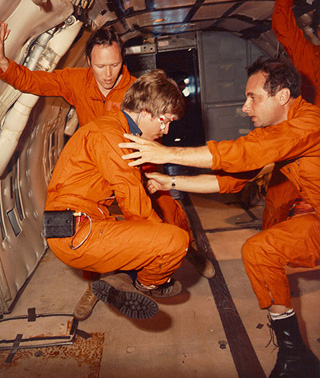
Larry Young prepares to spin Charles Oman during a 1979 vestibulo-ocular reflex study aboard the "vomit comet" reduced gravity aircraft. (Public domain image, source NASA.)
Instructor(s)
Dr. Charles M. Oman
Dr. Laurence R. Young
Dr. Daniel M. Merfeld
Dr. Kathleen Cullen
MIT Course Number
16.430J / HST.514J
As Taught In
Spring 2012
Level
Graduate
Course Description
Course Features
Course Description
This course introduces sensory systems and multi-sensory fusion using the vestibular and spatial orientation systems as a model. Topics range from end organ dynamics to neural responses, to sensory integration, to behavior, and adaptation, with particular application to balance, posture and locomotion under normal gravity and space conditions. Depending upon the background and interests of the students, advanced term project topics might include motion sickness, astronaut adaptation, artificial gravity, lunar surface locomotion, vestibulo-cardiovascular responses, vestibular neural prostheses, or other topics of interest.


